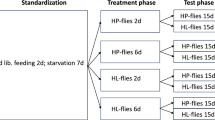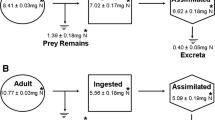Abstract
The effects of selenium (Se) accumulation in phytophagous insects on predators in the next trophic level were investigated. The generalist predator Podisus maculiventris Say (Hemiptera: Pentatomidae) was fed an herbivore Spodoptera exigua (Hübner) (Lepidoptera: Noctuidae) larvae from control diet and diets at two Se levels (0, 109, and 135 μg/g sodium selenate dry weight added). Predators reared on larvae grown on diets with sodium selenate took longer to complete each developmental stage and had significantly higher mortality rates. Predators achieving the adult stage on Se-containing hosts weighed 20% less than those feeding on control larvae. Reduced adult weight of insects has been associated with reduced fitness (longevity, egg production, etc.), which would have long-term negative impacts on population dynamics. These developmental and mortality effects resulted from biotransfer of Se, not biomagnification since the trophic transfer factor was less than 1.0 (∼0.85). Host larvae in Se-treatments contained significantly more total Se (9.76 and 13.0 μg/g Se dry weight host larvae) than their predators (8.34 and 11 μg/g Se dry weight predatory bugs, respectively). Host larvae and predators in the control groups did not differ in their Se content. These data demonstrate that Se in the food chain may have detrimental population level effects on insects even in the absence of biomagnification, given the host contains significantly elevated concentrations of selenium.
Similar content being viewed by others
References
Bañuelos, G.S., Ajwa, H.A., Mackey, B., Wu, L., Cook, C., Akohoue, S. and Zambruzuski, S. (1997). Evaluation of different plant species used for phytoremediation of high soil selenium. J. Environ. Qual. 26, 639-646.
Bañuelos, G.S., Tebbets, J.S., Johnson, J., Vail, P.V. and Mackay, B. (1999). Survey of insects and biotransfer of selenium from plants used for phytoremediation. Int. J. Phytoremed. 1, 311-26.
Besser, J.M., Geisy, J.P., Brown, R.W., Buell, J.M. and Dawson, G.A. (1996). Selenium bioaccumulation and hazards in a fish community affected by coal fly ash effluent. Ecotox. Environ. Saf. 35, 7-15.
Boyd, R.S. and Wall, M.A. (2001). Responses of generalist predators fed high-Ni Melanotrichus boydi (Heteroptera: Miridae): elemental defense against the third trophic level. Am. Midl. Natl. 146, 186-98.
Brown, G.E. Jr., Foster, A.L. and Ostergren, J.D. (1999). Mineral surfaces and bioavailability of heavy metals: a molecular-scale perspective. Proc. Natl. Acad. Sci. 96, 3388-95.
CH2M HILL. (1995). Kesterson Reservoir 1995 Biological Monitoring Report. Prepared for U.S. Bureau of Reclamation, Mid-Pacific Region by CH2M HILL, Sacramento, CA, USA.
Clausen, C.P. (1972). Entomophagous Insects, 688pp. New York: Hafner Publishing Co.
DeBach, P. (1973). Biological Control of Insect Pests and Weeds, 844pp. London: Chapman & Hall.
Ge, H., Cai, X.J., Tyson, J.F., Uden, P.C., Denoyer, E.R. and Block, E. (1996). Identification of selenium species in selenium-enriched garlic, onion and broccoli using high-performance ion chromatography with inductively coupled plasma mass spectrometry detection. Anal. Comm. 33, 279-81.
Hogan, G.R. and Cole, B.S. (1988). Survival of Tribolium confusum (Coleoptera: Tenebrionidae) in basal-casein medium supplemented with sodium selenite. Environ. Entomol. 17, 770-7.
Hogan, G.R. and Razniak, H.G. (1991). Selenium-induced mortality and tissue distribution studies in Tenebrio molitor (Coleoptera: Tenebrionidae). Environ. Entomol. 20, 790-4.
Lalitha, K., Rani, P. and Narayanaswami, V. (1994). Metabolic relevance of selenium in the insect Corcyra cephalonica: uptake of 75Se and subcellular distribution. Biol. Trace Elem. Res. 41, 217-33.
Laskowski, R. (1991). Are the top carnivores endangered by heavy metal biomagnification?. Oikos 60, 387-90.
Lauchli, A. (1993). Selenium in plants: uptake, functions, and environmental toxicity. Bot. Acta. 106, 455-68.
Lemly, A.D. (1996). Assessing the toxic threat of selenium to fish and aquatic birds. Environ. Monit. Assess. 43, 19-35.
Lemly, A.D. (1997). Environmental implications of excessive selenium: a review. Biomed. Environ. Sci. 10, 415-35.
Mackey, W.P., Mena, R., Gardea, J. and Pingatore, N. (1997). Lack of bioaccumulation of heavy metals in an arthropod community in the northern Chihuahuan Desert. J. Kans. Ent. Soc. 70, 329-34.
Maier, K.J. and Knight, A.W. (1993). Comparative acute toxicity and bioconcentration of selenium by the midge Chironomus decorus exposed to selenate, selenite, and seleno-DL-methionine. Arch. Environ. Contam. Toxicol. 25, 365-70.
Malchow, D.E., Knight, A.W. and Maier, K.J. (1995). Bioaccumulation and toxicity of selenium in Chironomus decorus larvae fed a diet of seleniferous Selenastratum capricornutum. Arch. Environ. Contam. Toxicol. 29, 104-9.
Martin-Romero, F.J., Kryukov, G.V., Lobanov, A.V., Carlson, B.A., Lee, V.N., Gladyshev, V.N. and Hatfield, D.L. (2001). Selenium metabolism in Drosophila: selenoproteins, selenoprotein mRNA expression, fertility, and mortality. J. Biol. Chem. 276, 29798-804.
Metcalf, C.L. and Flint, W.P. (1962). Destructive and Useful Insects, Their Habits and Control, San Francisco, CA: McGraw-Hill.
Pearson, A.C., Sevacherian, V., Ballmer, G.P., Vail, P.V. and Henneberry, T.J. (1989). Spring annual hosts of five noctuid pests in the Imperial Valley of California (Lepidoptera: Noctuidae). J. Kans. Entomol Soc. 61, 464-70.
Peterson, A. (1962). Larvae of Insects, an Introduction to Nearctic Species, Part 1: Lepidoptera and Plant-Infesting Hymenoptera, Ann Arbor, MI: Edwards Brothers.
Presser, T.S. and Ohlendorf, H.M. (1987). Biogeochemical cycling of selenium in the San Joaquin Valley, California. Environ. Manag. 11, 805-21.
Presser, T.S., Sylvester, M.A. and Low, W.H. (1994). Bioaccumulation of selenium from natural geologic sources in western states and its potential consequences. Environ. Manag. 18, 423-36.
Santolo, G.M. and Yamamoto, J.T. (1997). Prediction of Selenium Exposure and Hazards for Terrestrial Birds. 18th Annual Meeting, 16–20 November, San Francisco: Society of Environmental Toxicology and Chemistry.
Santolo, G.M. and Yamamoto, J.T. (1999). Selenium in blood of predatory birds from Kesterson Reservoir and other areas in California. J. Wildlife Manag. 63, 1273-81.
Schuler, C.A., Anthony, R.G. and Ohlendorf, H.M. (1990). Selenium in wetlands and waterfowl foods at Kesterson Reservior, California, 1984. Arch. Environ. Contam. Toxicol. 19, 845-53.
Simmons, T.W., Jamall, I.S. and Lockshin, R.A. (1988). Accumulation, distribution, and toxicity of selenium in the adult housefly Musca domestica. Comp. Biochem. Physiol. Pharmacol. Toxicol. Endocrinol. 91, 559-64.
Simmons, T.W., Jamall, I.S. and Lockshin, R.A. (1989a). Selenium modulates peroxidation in the absence of glutathione peroxidase in Musca domestica. Biochem. Biophys. Res. Commun. 165, 158-63.
Simmons, T.W., Jamall, I.S. and Lockshin, R.A. (1989b). Selenium-independent glutathione peroxidase activity associated with glutathione S-transferase from the housefly, Musca domestica. Comp. Bio. Physiol. 94, 323-27.
Sokal, R.R. and Rohlf, F.J. (1995). Biometry: The Principles and Practice of Statistics in Biological Research, 887pp. New York, NY: W. H. Freeman and Co.
StatView. (2000–2001). Version 5.0.1. Cary, NC: SAS Institute.
Thomas, B.V., Knight, A.W. and Maier, K.J. (1999). Selenium bioaccumulation by the water boatman Trichocorixa reticulata (Guerin-Meneville). Arch. Environ. Contam. Toxicol. 36, 295-300.
Tracy, M.L. and Möller, G. (1990). Continuous flow vapor generation for inductively coupled argon plasma spectrometric analysis. Part I. Selenium. J. Assoc. Off. Anal. Chem. 73, 404-10.
Trumble, J.T., Kund, G.S. and White, K.K. (1998). Influence of form and quantity of selenium on the development and survival of an insect herbivore. Environ. Poll. 101, 175-82.
Vickerman, D.B. and Trumble, J.T. (1999). Feeding preferences of Spodoptera exigua in response to form and concentration of selenium. Arch. Insect. Biochem. Physiol. 42, 64-73.
Vickerman, D.B., Shannon, M.C., Bañuelos, G.S., Grieve, C.M. and Trumble, J.T. (2002a). Evaluation of Atriplex lines for selenium accumulation, salt tolerance and suitability for a key agricultural insect pest. Environ. Poll. 120, 463-73.
Vickerman, D.B., Young, J.K. and Trumble, J.T. (2002b). Effect of Se-treated alfalfa on development, survival, feeding and oviposition preferences of Spodoptera exigua (Lepidoptera: Noctuidae). Environ. Entomol. 31, 953-9.
Wu, L., Chen, J., Tanji, K.K. and Bañuelos, G.S. (1995). Distribution and biomagnification of selenium in a restored upland contaminated from agricultural drainage water. Environ. Tox. Chem. 14, 733-42.
Author information
Authors and Affiliations
Corresponding author
Rights and permissions
About this article
Cite this article
Vickerman, D.B., Trumble, J.T. Biotransfer of Selenium: Effects on an Insect Predator, Podisus maculiventris . Ecotoxicology 12, 497–504 (2003). https://doi.org/10.1023/B:ECTX.0000003036.81351.31
Issue Date:
DOI: https://doi.org/10.1023/B:ECTX.0000003036.81351.31




